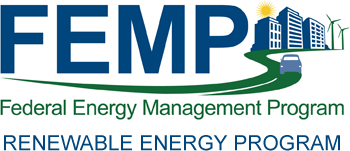Introduction
Within This Page
- Introduction
- Description
- Application
- Operation and Maintenance
- Special Considerations
- Additional Resources
THIS PAGE SUPPORTED BY THE
Geothermal electric uses geothermal energy to turn a turbine and generate electricity. The first geothermal power generator was tested in Italy in 1904. The first large-scale geothermal electric plant in the United States began operation in 1960, operating successfully for 30 years and producing 11 megawatts (MW) of net power. Geothermal technologies produce about one-sixth of the carbon dioxide that a relatively clean natural-gas-fueled power plant produces, and less than 1% of the carbon dioxide of a fossil-fuel plant. Geothermal electric power plants can run at 90% availability, and the hydrothermal fluids are recycled back into the earth after use.
The types of technologies typically used in geothermal electric power plants include binary cycle, dry steam, and flash steam power plants. Dry steam power plants use geothermal steam of 150°C (302°F) or more, whereas flash steam power plants require relatively high-temperature geothermal resources at about 180°C (356°F). Binary-cycle, or organic Rankine cycle, power plants use lower temperature geothermal resources around 100°C (212°F), which is a major advantage in areas where only lower temperature resources are available. The corresponding photo shows The Geysers, a dry steam geothermal electric power plant in northern California and the world's largest geothermal field.
Geothermal electric is not a widely used renewable energy technology for most new construction or major renovation projects since most buildings do not have direct availability to a geothermal resource. Furthermore, geothermal electric plants require a large capital investment and a typical building budget that does not allow for building this type of a power plant. A site, however, can purchase their electricity from an existing geothermal electric plant if available. If a project warrants a larger generation facility, especially one that can also make use of steam and process heat, geothermal electric in a combined heat and power system may be an option.
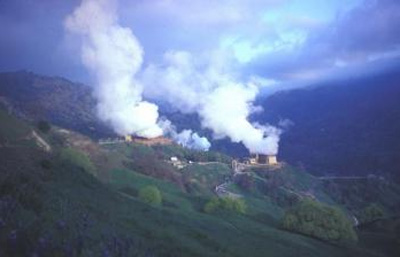
The Geysers, near Santa Rosa in northern California, is the world's largest electricity-generating geothermal development.
This overview is intended to provide specific details for those considering geothermal technologies as part of a major construction project. Further general information is available from the U.S. Department of Energy (DOE) Office of Energy Efficiency and Renewable Energy (EERE) Geothermal Electricity Production Basics.
Description
The conversion technologies from hydrothermal fluids to electricity include flash steam, dry steam, and binary-cycle power plants. Each geothermal electric system is made up of several key components including a:
- Production well
- Turbine
- Generator
- Injection well.
Dry steam power plants are the simplest and oldest design, upon which the two other systems are based. They use a geothermal production well that produces fluid heated by the natural heat of the earth. The steam goes directly to a turbine, which drives a generator that produces electricity. The fluid then goes into an injection well, which is a well that is specifically drilled for the safe disposal of the geothermal fluids.
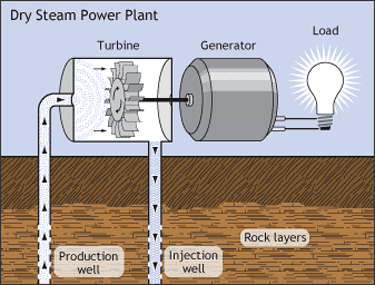
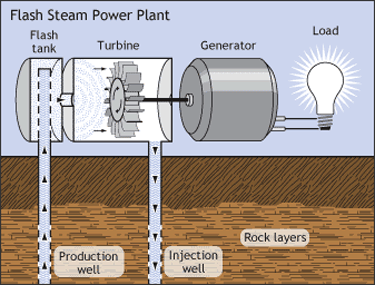
Dry steam power plant.
Flash steam power plant.
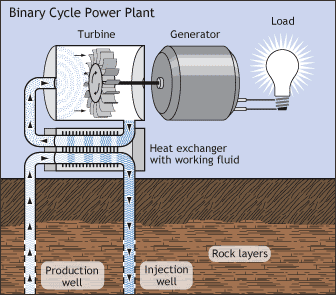
Binary cycle power plant.
Binary-cycle power plants take the hot geothermal fluid from the production well, but also use a secondary fluid, which passes through a heat exchanger. Energy is extracted from the hydrothermal fluids causing the working fluid to vaporize, drive the turbine, and generate electricity.
Types and Costs of Technology
Binary-cycle power plants are the most common type of geothermal power generation in use today. The secondary fluid used in these plants is usually isobutene or isopentane. Since the geothermal fluid passes from the production well, heats the secondary fluid, and goes back down the well, the binary-cycle power plant is a closed loop system. Therefore, there is virtually nothing emitted into the atmosphere. The U.S. Department of Energy is working to achieve $0.03 to $0.05 per kilowatt-hour (kWh); 15,000 MW of new capacity are estimated within the next decade.
Application
The United States leads the world in electricity generation with geothermal power, producing 14.86 billion kWh, or 0.4% of the total U.S. electricity in 2008. The United States Geological Survey estimates that 70% to 80% of geothermal resources are hidden, making it a challenge to find a site. As a result, investigators are currently working on issues in drilling, resource usage, equipment, and geochemistry.
A good geothermal site includes:
- Hot geothermal fluid with low mineral and gas content
- High average thermal gradients
- High rock permeability and porosity while keeping fluids in place
- Shallow aquifers for producing and re-injecting hydrothermal fluids
- Private land, which helps simplify the permitting process
- Make-up water availability, necessary for evaporative cooling.
Geothermal electricity systems are typically most economic in large, utility-scale applications. Many Federal facilities will not be interested in building a geothermal electric power plant, considering the limited resource availability and the high capital cost. Military installations may be interested in baseload, renewable power, and facilities near lower-temperature resource may be able to take advantage of combined heat and power applications. The Massachusetts Institute of Technology released The Future of Geothermal Energy , an in-depth report that evaluates the potential use of geothermal energy within the United States.
Economics
As with most renewable energy technologies, geothermal power plant costs are heavily weighted toward construction and early expenses, rather than toward the operation. This includes well drilling, pipeline construction, resource analysis, and power-plant design. Capital investment can be split into three phases: exploration and drilling, construction of power facilities, and discounted future re-drilling/well stimulation. The capital cost for a geothermal power plant is about $2,500 per kilowatt (kW), whereas operation and maintenance costs range from $0.01 to $0.03 per kWh.
Tax incentives and various forms of financing are often used to offset costs of developing a geothermal power project. Tax incentives, including property and sales tax incentives, and tax credits, provide an incremental motivation for geothermal electric development. They can be used for both small and large projects, since they are often based on a percentage of total costs or the market value of the equipment.
Loans are a common financing mechanism for geothermal electric projects. There are loan programs that may be used for this technology; however, many direct loan programs are more appropriate for geothermal heating and cooling projects.
Assessing Resource Availability
In the United States, geothermal is mostly found in the western states and Hawaii, with geothermal power plants in seven states. California has 34 geothermal power plants, producing almost 90% of the United State's geothermal electricity. Nevada has 16, and Hawaii, Idaho, Montana, and Utah are each running one plant.
The corresponding figure shows the geothermal resources of the United States. The red and orange colors indicate the most favorable locations for geothermal systems, which are mostly located in the western half of the United States. Currently, the United States has the largest geothermal electric generating capacity in the world. The total generating capacity worldwide is estimated to be between 35 and 2,000 gigawatts (GW) and the current installed geothermal electric capacity worldwide is 10.7 GW.
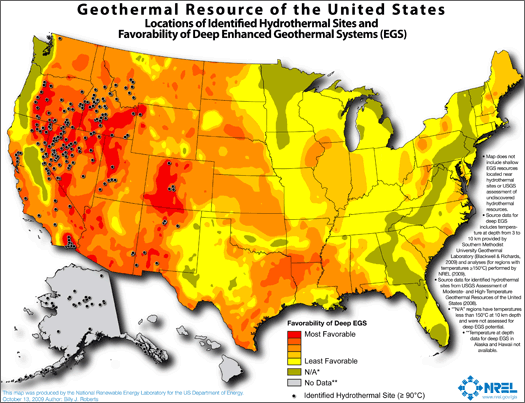
Map of geothermal resources in the United States.
Procurement Considerations
Given the high capital cost of these power plants, geothermal electric facilities generally supply base-load power to grid operations under a long-term power purchase agreement in order to acquire funding for the initial investment.
The Federal Energy Management Program (FEMP)'s Guide to Integrating Renewable Energy into Federal Construction has more information on renewable energy project funding options, including power purchase agreements, energy savings performance contracts, and utility energy service contracts.
Operation and Maintenance
Geothermal plants are capital-intensive, but are relatively cheap to run. Costs range from $0.01 to $0.03 per kilowatt-hour, and can operate at 90% availability or more. Maintenance costs increase if a geothermal power plant operates at greater than 90% availability. This high price is justified, because the maintenance costs are covered by the increased production of the plant.
Special Considerations
Special considerations for geothermal electric system design and installation include interconnection and environmental review and permitting:
Interconnection
A geothermal electric system that will be connected to the utility grid must meet interconnection requirements of the local utility. Since geothermal electric systems are rarely sized for customer-sited applications, these facilities will be subject to the broader interconnection rules of independent power plants. The state public utility commission and the local utility for the site are the best resources for interconnection rules.
The Database of State Incentives for Renewables & Efficiency (DSIRE) is a comprehensive source of information on state, local, utility, and federal incentives and policies that promote renewable energy and energy efficiency.
Environmental Review/Permitting
Most of the important environmental impacts from any geothermal electric power plant are associated with ground water use and contamination. There are concerns about land subsidence and induced seismicity as a result of water injection and production into and out of a reservoir. Other issues such as air pollution, noise, safety, and land must also be considered. Any new geothermal plant is likely to add considerable issues to a National Environmental Policy Act review, and the permitting process can be time consuming.
Additional Resources
Publications
- The National Renewable Energy Laboratory's Policymakers' Guidebook for Electricity Generation outlines five steps for implementing geothermal policy.
Organizations
- Great Basin Center for Geothermal Energy (GBCGE) provides maps, data, and research on geothermal resources.
- Geothermal Rising formerly the Geothermal Resources Council, actively seeks to expand its role as a primary professional educational association for the international geothermal community and serves as a focal point for continuing professional development for its members through its outreach, information transfer and education services.

